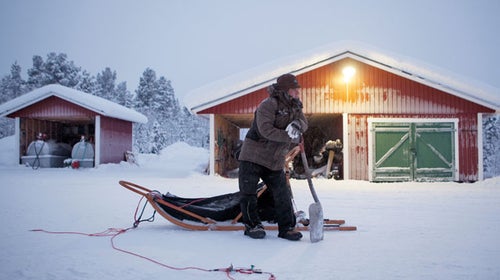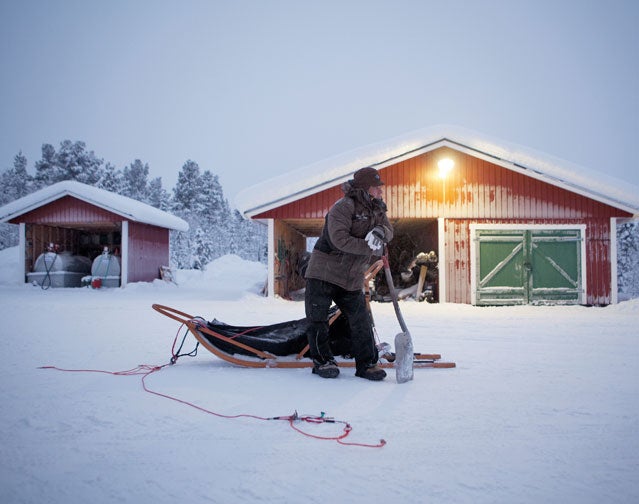The sky is gunmetal gray, a shade somewhere between inviting and malicious. We’re 40 miles due east of Tromsø, Norway, a city that sits on the Norwegian Sea more than 180 miles north of the Arctic Circle. Yesterday, kiteboarders were ripping across the frigid late-April water propelled by gusty winds, a testament to the commonly held belief that of the three Scandinavian bloodlines—Norwegian, Danish, and Swedish—Norwegians are the most hardcore. The proponents of that stereotype, however, have yet to meet Kenth Fjellborg, Arctic Swede.
The Snow Report
The latest snow, ski, and winter sports stories from ���ϳԹ���.Mushing to the Väkkäräjärvi lodge
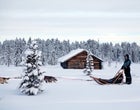 Mushing to the Väkkäräjärvi lodge
Mushing to the Väkkäräjärvi lodgeFjellborg with his wife, Ann, and daughter Amanda
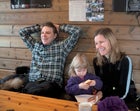 Fjellborg with his wife, Ann, and daughter Amanda
Fjellborg with his wife, Ann, and daughter AmandaThe Sevuvuoma homestead
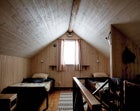 The Sevuvuoma homestead
The Sevuvuoma homesteadFjellborg's kennels
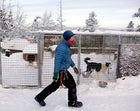 Fjellborg's kennels
Fjellborg's kennelsReindeer skins to keep mushers warm
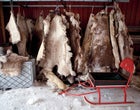 Reindeer skins to keep mushers warm
Reindeer skins to keep mushers warm��
“Get dressed! Put your boots on!” Fjellborg shouts to jolt us out of the heated van. “When we get going, we’re not going to stop! The sun is hiding in the sky, but we’re going to go right into the white! Men, you do the number one outside. The outhouse is not for gentlemen. But I hate it when pee is spread over the snow.”
It’s the first morning of our journey, and the marching—or, rather, mushing—orders have begun. Six of us, all neophytes, will be guided by Fjellborg on one of his most rigorous Arctic dogsledding adventures. We’re lined up like a United Nations train: Fjellborg is in front; the three American, one British, and two Swedish sledding rookies are in the middle; and 26-year-old Norwegian-Scottish guide Amanda Calder, who wears two knives at all times—one for dogs and one for humans—brings up the rear.
We’ll each lead a team of five or six dogs on a five-day, 160-mile journey from the old Rognli homestead, which sits in the Signal Valley, on a historic backcountry “highway” between Norway and Sweden. We’ll climb 2,400 feet into the Arctic tundra, then travel southeast along frozen waterways that will lead us to Fjellborg’s home in the Swedish village of Poikkijärvi. Poikkijärvi is on the banks of the Torne River, directly across the water from Jukkasjärvi, the village Fjellborg’s ancestors first inhabited in 1690. Nine generations of Fjellborgs have lived within a 25-mile radius of Jukkasjärvi ever since.
But first, a dose of äkta svensk gästfrihet—genuine Swedish hospitality. Cooking over an open fire, Fjellborg and his pit crew of two, who helped transport our 46 dogs and will leave us here, have set out a small smorgasbord of reindeer stew, lingonberry jam, and mashed potatoes, along with that staple of the Swedish backcountry diet, polar bread—a whole wheat pita topped with butter and cheese.
The hearty brunch, inspired by the Sami, who have herded reindeer in the northern latitudes for 8,000 years, will fuel us until we reach Pältsa, the Swedish Tourist Association’s northernmost mountain hut, which will be our home our first night and sits across the border in Sweden, about 20 miles from here, at 68.8 degrees north latitude. The hut was used during World War II as a base for Norwegian resistance fighters. Farther along the trail, we’ll stay at a Sami-run fishing camp, then at the residence of an old Swedish family who’ve lived here almost as long as the Fjellborg clan, and, finally, at Sevuvuoma, an ancestral Fjellborg homestead, which Fjellborg bought from a distant cousin and has recently renovated. From there we’ll mush roughly 20 miles to his house in Poikkijärvi.
“Do you know the Sami word for ‘vegetarian’?” Fjellborg asks. “Poor hunter!”
Then he gets down to business.
“Ladies and gentlemen, we’ve been talking and eating, and now we are going to go,” says the 42-year-old musher. Fjellborg is blond, strong, and five foot ten—a relatively modest height that he blames on a lack of leafy greens in his childhood diet. His blue eyes have been scanning the darkening sky since we arrived, so he hurries us through a truncated version of dogsledding 101.
“If you don’t work the brake, you will have difficulty steering the sled,” he says. “Have pressure in the lines, and put your lead dog in first. And don’t let the team go. If you do, I will scream at you in bad words!” One more thing, he adds: “Don’t scream at your dogs. They are all trying their best.”
“Do they speak English?” asks Todd Fairbairn, a 43-year-old entrepreneur from New York City.
“Just don’t speak German to them,” says Fjellborg. “They don’t like that.”
My team of honey-colored Alaskan huskies, with Morris and Trista in front, Meyra in the middle, and Nelson and Whopper in back, are small but feisty. Whopper is nipping at Nelson, Nelson is baying like a treed lion, and Morris is pooping on the pure white snow.
By now the dogs are going ballistic, yelping and straining at their collars. Fjellborg releases his brake, which unleashes a chain reaction of howling beasts that charge into the white abyss.
THERE ARE MANY time-honored Scandinavian traditions. Dogsledding is not one of them. In Jukkasjärvi, the sport goes back only 50 years. When the Sami, who preceded Fjellborg’s family by a few millennia, needed transportation, they hitched their reindeer to a sled or skied. A carbon-dated ski fragment found in Russian Lapland predates the invention of the wheel.
Today, however, the human-to-dog ratio in Jukkasjärvi is 519 to 1,000. The influx of dogs is thanks to Fjellborg and a few local kennels, but it’s also the result of an increasing worldwide fascination with harnessing the power of man’s best friend. In the Scandinavian countries, especially Norway, the number of competitive mushers has grown exponentially in the past decade.
“Either you gotta be tough or you gotta be stupid,” Fjellborg likes to say about making a living 124 miles north of the Arctic Circle. It seems he’s the former. In the past 25 years, he has created what amounts to a Swedish dogsledding dynasty, and he now has 125 selectively bred Alaskan huskies he keeps in immaculate kennels in his vast yard.
“I breed the best,” Fjellborg says. “If you’re interested in motorcycles, you like a good motorcycle. If you’re interested in dogs, you like a good dog.”
In addition to the kennels, Fjellborg’s home base includes a house, a separate suite of rooms with a sauna for guests, a garage full of winter toys—from skis to kid-size Arctic Cat snowmobiles—and, of course, the ubiquitous Volvo station wagon. He shares the compound with his wife, Ann, 42, a lithe, blond skier from southern Sweden, and their three towheaded little girls, Klara, 9, Elina, 7, and Amanda, 4. Occasionally, Fjellborg’s unofficially adopted son, a 56-year-old Sami reindeer herder named Nils Anders Blindh, who jokingly calls Fjellborg Dad, shows up at the house to make the morning coffee. Fjellborg’s father, a retired cop, and mother, who still bakes the family bread in a massive wood-fired oven, live next door.
Fjellborg is an anomaly in a country where the national ethos is logom, an old Viking term derived from the words laget om, which literally mean “team wise” but refer to the mandatory sharing of booze after pilfering it from enemies. Today the term suggests approaching everything in life, including entrepreneurship, in moderation.
“When I was 16, I wanted to be like Onassis. Do you know him?” Fjellborg asks me during a lunch break a few days into the trip. “I heard he had lots of chicks. So I got a big wooden boat to take tourists up the Torne River.”
After saving money from his tour-boat operation, Fjellborg began working with dogs at a kennel near his village. In 1989, he won the first dogsled race he entered, Sweden’s Nordic Marathon, which inspired him to fax a letter to Alaskan Joe Runyan, that year’s Iditarod champion, to ask if he could work for him.
“I was really into racing and wanted to see how the big boys were doing it,” says Fjellborg.
When Runyan responded with a yes, Fjellborg moved to Alaska to learn the competitive side of dogsledding. He was 19.
“Kenth was a lively guy,” says Runyan, now 63. “I had a five-mile hill that I used to run. Every once in a while, I’d sucker him into going with me. I don’t remember if he ever beat me, but he definitely could keep up. That was part of the job description: tough-guy musher trying to win the race. Kenth bought into that.”
In 1990, Fjellborg returned to Sweden to complete a then mandatory ten-month stint in the Swedish army, joining the Arctic Rangers, soldiers trained to survive the most extreme cold and operate behind enemy lines. That same year, he bought his first Alaskan husky, a female named Derby, for $3,500. By 1994, Fjellborg had bred, bought, or borrowed enough dogs from Runyan to assemble a strong team that nabbed a top-20 finish at the 1,150-mile Iditarod; he wears the medal, a brass belt buckle, to hold up his pants. Since 1995, when he started his dogsledding business, Fjellborg Arctic Journeys, he has taught Lauren Hutton how to mush; wrangled dogs for a Van Halen video; guided Monaco’s Prince Albert II on his successful 2006 expedition to the North Pole; produced an Arctic leg of the 2010 Amazing Race; and hosted Crown Princess Victoria of Sweden at the renovated family homestead in Sevuvuoma. He runs trips 120 days a year, from longer, expedition-style adventures to shorter outings.
Fjellborg’s reputation has spread thanks to his connection with the Ice Hotel, the 59,000-square-foot snow palace in Jukkasjärvi that attracts 50,000 visitors annually. For the past 21 years, carefully selected artists have created what look like real-time renderings of their best psychedelic dreams using only snow, ice, and sneece (a combination of ice and snow) mined from the Torne. A 2011 favorite was the Bubblesuite, a whimsical bedroom straight out of a James Bond film with reindeer skins on the bed and curvy ice-bubble walls, created by two Dutch artists.
Fjellborg oversees the hotel’s sled-dog experiences for guests. He also provides authentic Swedish resourcefulness to clients who use the Ice Hotel’s surreal backdrop for ad campaigns. Two years ago, the creative director from Hermès flew from Paris with 21 employees for a fashion shoot. Fjellborg’s job was to scout the perfect location for an image of a dog team rounding a bend in the woods. That one shot took three days.
All told, Fjellborg and his staff take out upwards of 5,000 clients a year. “What is stimulating to me is that I live 100 miles north of the Arctic Circle, and I don’t have to go anywhere to meet people. They all come to me,” he says. “Yet I can still take part in what my ancestors have done—catching game, hunting, and fishing.”
“I may not be street-smart,” says Fjellborg, who ranks driving through Milan as the most terrifying experience of his life. “But I know my way around the woods.”
HOPEFULLY, FJELLBORG knows his way around the open tundra. It’s day two of the expedition, and last night, right after we were greeted at Pältsa by the caretaker and two Finnish skiers who were thawing out in the communal kitchen, the weather went bonkers. The wind was so strong that the snow was falling horizontally.
Pältsa sleeps 22 guests in two huts, in rooms lined with bunk beds, and is situated in one of the most beautiful locations on the trail, which makes it a popular stop on the Arctic snowmobile circuit. But today it’s just a couple of brave Finns on skis and us.
Fourteen hours later the wind and snow haven’t let up, but Fjellborg is cracking jokes at breakfast.
“If you want to learn Swedish, listen to me, not them,” he tells the non-Swedes as we eat our oatmeal. “One hundred years ago, people spoke Finnish, not Swedish, up here, so we’ve learned a more correct language.”
Fjellborg is comparing his Swedish with that of Andrea Westerlind, 30, and Martin Berling, 35, the two other Swedes in our group, who moved from Stockholm to New York City to introduce Sweden’s premier outdoor-clothing brand, Fjällräven, into the U.S. market. Fjellborg has been a guide, organizer, and logistics man for many of the company’s product-development and testing expeditions for more than 20 years.
“Kenth, did you know the original people came from Africa and not Sweden?” says Berling, who, at well over six feet tall and with a full red beard, looks like a 21st-century hipster Viking.
After breakfast I suit up in a Fjellborg-issued snowsuit, a fur-lined bomber hat, and custom-made polar boots. The temperature is in the mid-twenties, and the dogs are almost buried in snow. A few of us try to coax them out of the fetal position with a mixture of chicken, lamb, and beef that Calder has spent the past hour hacking into bite-size pieces and mixing with water into a cold doggie stew.
After the dogs are fed and the sleds are loaded, the clouds part and a small patch of blue appears in the sky. The wind, however, is so strong that I can’t walk in a straight line. We have at least 30 miles to travel today, so it’s time to mush. When all goes well, we cover approximately ten miles an hour. We harness the dogs, and then Fjellborg gives us two rules.
Rule number one: Stay close.
Rule number two: Don’t lose your gloves.
We set off on an unnamed trail, marked every 50 feet or so by a five-foot wooden pole with a red cross on top. The scenery is supposedly breathtaking, a wide-open range of low, rounded 800-foot peaks combined with palsas—giant weather-sculpted frost heaves that push up in frozen waves. But we’re in a universe of howling white nothing. The snow is blowing so low, fast, and hard that what little I can see looks straight out of one of those cheesy movies depicting heaven, if heaven had 50-mile-per-hour winds. I’m not cold, but the white-on-white void induces vertigo, and the pelting snow is relentless. Luckily, the musher in front of me—Raan Parton, a 30-year-old cofounder of Apolis, an apparel company in Los Angeles—is wearing bright red snow pants. It’s the only marker keeping me on track.
We bounce up and down on the sleds like bobbleheads for a few hours until Fjellborg stops, sets his sled’s claw brake, and starts trudging back toward Calder at the end of the line, where they huddle over what looks like a GPS unit.
Ten minutes later, Fjellborg backtracks on foot along the route we just traveled and is immediately out of sight. After a few minutes, he reappears and returns to his sled.
“Follow me, and kick a little bit!” he commands as he turns the train around.
How far off track are we? I don’t ask. Now is not the time to question. I release the brake and mush.
Dogsledding is not difficult, but it does require prolonged focus. During distance events like the Iditarod, hallucinations are common. Operating on too little sleep, Fjellborg once conjured up an old Swedish barn while mushing on Alaskan sea ice, and Calder kept seeing ghost bridges during one endurance-mushing escapade. The bridge mirage, common among mushers, has something to do with the way their hat brims block their line of sight.
I’m not hallucinating, but I am having trouble controlling my sled. My team, which has been charging hard since the start, keeps veering dangerously close to the wooden markers. To weave around the signposts, I throw my weight in the opposite direction, but, finally, the inevitable happens: the dogs swerve, and I smash into a pylon, which gets firmly lodged under the sled. Despite 50 pounds of added resistance, the dogs don’t stop, and I can’t brake because the pylon is between the brake jaw and the ground. Besides, if I stop, I’ll be lost. So I push on, brakeless, until the pylon works its way out from under the sled about a mile later.
We eventually find camp—a cluster of Sami-owned fishing cabins nestled on the shore of a massive lake that we can’t see. Once again, two Finns—a different duo from the pair we met at Pältsa—have arrived before us, this time by snowmobile, and they reek of liquor.
“Where are you from?” they ask. “We are from Finland!”
That night, over a dinner of arctic char, sauerkraut, and potatoes that Fjellborg whips up in his cabin’s tiny kitchen, Westerlind uses her iPhone calculator to confirm that the wind speed was at least 50 mph. Someone else asks Fjellborg how lost we were.
“You don’t have to know exactly where you are, just the neighborhood,” he responds. “It’s much better not to think about it too much.”
���� ��
THE NEXT MORNING, we wake up to an alternate universe, the Arctic of expedition dreams, in which there are no clouds and it’s so bright and clear that I can see the silhouette of a lone reindeer, head bent in search of lichen, on top of a low hill a mile away. After a few hours, we descend below the tree line and pass a white ptarmigan in the brush hiding from the dogs. Our objective is to reach Fjellborg’s home in Poikkijärvi by Thursday, which gives us two and a half days to cover 100 miles.
The first night, we stop in the village of Kattuvuoma. Oddly, there are cars here but only 12 miles of road. The closest road that connects to anything is 16 miles away. People tow the cars into the tiny settlement over the ice in the winter and use them only in the summer.
We’re staying at the yellow farmhouse of Sven-Erik Stöckel, a 76-year-old descendant of a bear hunter. His grandfather’s traps, along with fishing nets, skis, spears, saws, scythes, and a long wooden contraption that turns out to be a sheep castrator, are still in the barn out back, which he calls his museum. “This is what your wife is going to do with you when you get home,” says Fjellborg to James Bishop, 41, a Brit whose wife gave birth four months ago, as he makes a giant chopping motion with the castrator.
Later that evening, Stöckel explains that during World War II, this area, known only as North of Tornetrask Lake, was a popular corridor for Russians, Poles, and Germans trying to escape the Nazis. His parents harbored them, along with Norwegian resistance fighters, who had a base atop an unnamed peak nearby.
“Sven-Erik’s mom and dad saved a lot of lives,” Westerlind tells me as she translates his story from Swedish.
The next day, we mush across a string of iced-over lakes, whipping snowballs at each other. In some places, the turquoise water is exposed. The dogs seem to have a sixth sense for the holes, some of which I narrowly avoid.
By late afternoon, we’ve reached what looks like a brand-new red farmhouse and low-slung barn amid several neglected log buildings. It’s the homestead in the village of Sevuvuoma that Fjellborg bought from a distant cousin and renovated. He fortified the farmhouse’s original interior log structure, and his wife decorated it with Swedish antiques they hauled in by boat. Black-and-white photos of Fjellborg’s ancestors hang on the log walls, and a scrapbook contains photos of Princess Victoria having a picnic on the lawn. It’s all very Ralph Lauren meets Scandinavian country chic. Fjellborg gives us a tour, then schools us with a family-history lesson.
“My distant cousins were very good hunters and always had a big stack of moose meat they hid under the frozen woodpile,” he tells us. “They didn’t want to show everybody how much meat they had because at that time there was not much moose around, and hunting times were limited.”
Almost 100 years later, the Fjellborgs still live large. Just because we’re deep in the Arctic doesn’t mean we’re deprived of luxury. Later, by candlelight, we drink cabernet sauvignon out of long-stemmed crystal glasses, eat curried arctic char (which Fjellborg has produced in a galley kitchen with no running water), and laugh over Westerlind’s gutsy tackle of a runaway dogsled team earlier in the day. The next morning, we mush to Poikkijärvi, where Fjellborg’s three daughters, dressed in snowsuits and flower-print rubber boots, rush out to hug their dad, while the rest of us bid a melancholy goodbye to our worn-out dogs.
But before we go our separate ways, for our final night, Fjellborg breaks out a celebratory bottle of Minttu peppermint schnapps for a toast in preparation for the most sacred Scandinavian ritual of all.
“Minttu is Finnish for ‘cold on the outside, warm on the inside,’ ” he says as he raises his glass. “And now we’re going to have one hell of a sauna.”
Access and Resources
Fjellborg Arctic Journeys offers three expedition-style dogsled adventures, numerous shorter options, and customized trips. The five-day Signal Valley Expedition costs $4,150; . At Jukkasjärvi’s Ice Hotel, sleep on ice while swaddled in reindeer skins one night, then in a cozy heated lodge room the next. Two-night packages start at $1,630; .
HOW TO GET THERE: Scandinavian and other airlines fly to Tromsø via Oslo inbound. (Fly Scandinavian from Kiruna to Stockholm back to the States.) For a stay at the Ice Hotel, fly from Stockholm to Kiruna; from there, it’s a 20-minute drive to Jukkasjärvi and the hotel.
WHEN TO GO: Mid-March to mid-April is ideal—the days are longer, the temperatures are warmer, and there’s still plenty of snow. But visit the Ice Hotel between December and early April, before it melts.
ALSO CHECK OUT: If you have a few extra days, fly to Göteborg on Sweden’s west coast (a.k.a. the “best coast,” per locals), rent a Volvo at the airport, and set out on a self-guided tour of the rocky coastline and the 8,000 islands that stretch 100 miles to the Norwegian border. Stay in historic seaside hotels like the Strandflickorna in Lysekil (doubles from $218; ); kayak the tide-free Bohuslän archipelago, near the seaside town of Smögen (guided day trips, $160; ); and take an oyster safari with local fisherman Per Karlsson and his daughter Hanna on their teak pleasure cruiser ($100; ). In Strömstad, take the ferry to North Koster Island, the car-free headquarters of newly anointed Kosterhavet Marine National Park, which covers 174 square miles and is home to more than 6,000 marine-animal and seaweed species. Stay at the sprawling Ekenäs Hotell Sydkoster (doubles from $200; ). For more information, go to .
